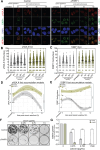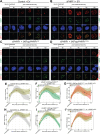Histone H3 N-terminal recognition by the PHD finger of PHRF1 is required for proper DNA damage response
- PMID: 40671529
- PMCID: PMC12266144
- DOI: 10.1093/nar/gkaf666
Histone H3 N-terminal recognition by the PHD finger of PHRF1 is required for proper DNA damage response
Abstract
Plant homeodomain (PHD) fingers are critical effectors of histone post-translational modifications (PTMs), regulating gene expression and genome integrity, and are frequently implicated in human disease. While most PHD fingers recognize unmodified and methylated states of histone H3 lysine 4 (H3K4), the specific functions of many of the over 100 human PHD finger-containing proteins are poorly understood. Here, we present a comprehensive analysis of one such poorly characterized PHD finger-containing protein, PHRF1. Using biochemical, molecular, and cellular approaches, we demonstrate that PHRF1 robustly binds to histone H3, specifically at its N-terminal region. Through integrating RNA-seq and proteomic analyses, we show that PHRF1 regulates transcription and RNA splicing and plays a critical role in DNA damage response (DDR). Crucially, we show that a cancer-associated mutation in the PHRF1 PHD finger (P221L) abolishes its histone interaction and fails to rescue defective DDR in PHRF1 knockout cells. These findings underscore the importance of the PHRF1-H3 interaction in maintaining genome integrity and provide new insight into how PHD fingers contribute to chromatin biology.
© The Author(s) 2025. Published by Oxford University Press on behalf of Nucleic Acids Research.
Conflict of interest statement
Figures









Update of
-
Histone H3 N-terminal recognition by the PHD finger of PHRF1 is required for proper DNA damage response.bioRxiv [Preprint]. 2024 Nov 20:2024.11.20.623956. doi: 10.1101/2024.11.20.623956. bioRxiv. 2024. Update in: Nucleic Acids Res. 2025 Jul 8;53(13):gkaf666. doi: 10.1093/nar/gkaf666. PMID: 39605374 Free PMC article. Updated. Preprint.
References
-
- Jenuwein T, Allis CD Translating the histone code. Science (1979). 2001; 293:1074–80. - PubMed
MeSH terms
Substances
Grants and funding
- T32CA217824/NH/NIH HHS/United States
- R44 GM116584/GM/NIGMS NIH HHS/United States
- Bourse de formation Desjardins pour la recherche et l'innovation
- PF-20-149-01-DMC/American Cancer Society
- R35 GM126900/GM/NIGMS NIH HHS/United States
- R44GM116584/EpiCypher
- Fondation CHU de Québec, a Bourse Distinction Luc Bélanger
- FRQS; 312369/Fonds de Recherche du Québec-Santé
- Cancer Research Centre - Université Laval
- T32 CA217824/CA/NCI NIH HHS/United States
- P30 CA016086/CA/NCI NIH HHS/United States
- R35GM126900/EpiCypher
- UNC Lineberger Cancer Center
LinkOut - more resources
Full Text Sources
Miscellaneous

